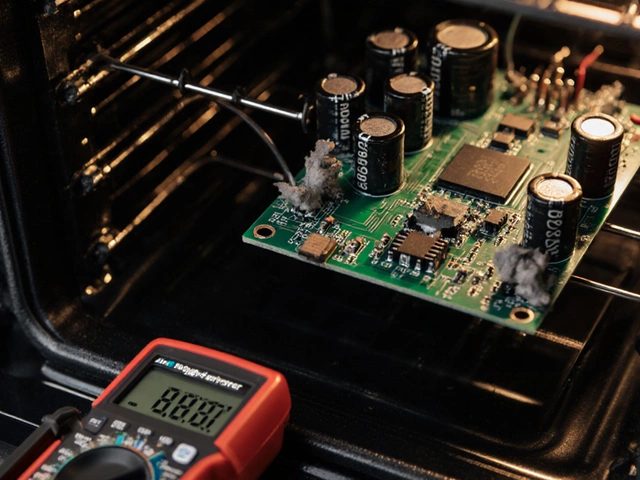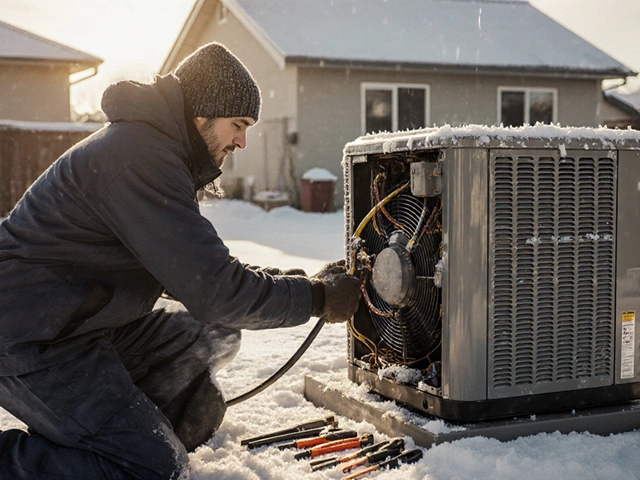If your oven just isn't heating up the way it used to, the element could be on its last legs. Nobody wants to start dinner only to find a half-baked mess staring back at them. Before you sound the alarm and call for help, you can check a few things right at home.
The element is the part that glows red-hot when you crank up the heat. If it's gone cold, or you see weird spots or breaks along its length, there's a real chance it's busted. Some ovens throw out uneven heat or take ages to warm up when the element starts to fail.
Get a flashlight—peek inside your oven when it's off and cold. Check for burns, blisters, or missing chunks on the element itself. These are dead giveaways something’s wrong. If you can turn the oven on and the element doesn’t turn red, that’s another big clue.
Don’t go poking around with the oven plugged in, though. Unplug or flip the breaker to kill the power first. Safety before curiosity, always. The good news? Most element problems are easy to spot yourself, no fancy tools needed.
- What Does an Oven Element Do?
- Clear Signs Your Oven Element Might Be Broken
- Quick Safety Check Before Inspection
- Hands-On: How to Test Your Oven Element
- When to Fix and When to Replace
What Does an Oven Element Do?
The oven element is the main part that heats your food. It’s basically a metal coil or rod, found either at the top or bottom (sometimes both) inside your oven. When you turn your oven on, electricity runs through that coil, which then gets super hot and cooks everything inside. No hot element means no roasting, baking, or broiling—no exceptions.
Most electric ovens run with two elements: one up top for broiling and another on the bottom for baking. These elements can reach temperatures of 350°F to 500°F (that’s about 180°C to 260°C). The bottom one is used most often, especially for baking or roasting.
- The key job of the oven element: convert electricity into steady, even heat.
- The element responds to your temperature knob or digital setting and tries to keep the oven at that exact number.
- Without a working element, even if the lights and fan are running, there’s not enough heat to cook food properly.
- Oven element issues are the most common reason home ovens stop heating.
For folks who like numbers, here’s a quick look at standard element stats:
| Typical Oven Element Fact | Average Value |
|---|---|
| Average lifespan | 5-8 years |
| Wattage (residential) | 2000-3000 watts |
| Operating temperature range | 350-500°F |
Long story short, that simple metal loop is what stands between you and a cold, uncooked dinner. If it fails, your oven just becomes a fancy bread box.
Clear Signs Your Oven Element Might Be Broken
Not sure if your oven element is busted? There are simple clues you can spot without tools or tech know-how. Here are the top red flags that something’s wrong.
- Oven Element won’t heat up or won’t glow red when the oven's on. A healthy element always lights up, even if it takes a minute.
- The element has visible burns, cracks, or obvious breaks. If you spot any burnt spots or the element looks split, it’s toast.
- Your food cooks unevenly, with one side raw and the other burnt. That’s because a dying element can’t spread heat properly.
- Preheating time suddenly jumps up. For most ovens, getting to 350°F takes 8-12 minutes. If it drags much longer, suspect the element.
- Sparks, smoke, or blown fuses happen as soon as you start the oven. A shorted element sometimes takes your breaker down with it.
If you want it even clearer, here’s a quick table with common symptoms and what they usually mean:
| Symptom | Possible Cause |
|---|---|
| Element won't glow | Element burned out or electrical fault |
| Visible damage (burns, splits) | Physical failure of element |
| Long preheat times | Weak or failing element |
| Uneven cooking | Element not heating fully |
| Sparks/flickering | Short or break in element |
Some ovens act up once before the element quits for good. Don’t ignore the first warning signs. A bad element can cause bigger headaches down the road, like blowing the main fuse or even damaging your oven controller.

Quick Safety Check Before Inspection
Before you get anywhere near your oven’s guts, hit pause and make sure you’re playing it safe. That sounds basic, but every year, kitchen accidents send thousands of people to the ER because of skipped steps and electric shocks. So, never skip this part—even if you’re in a hurry to get things running again.
First rule: always disconnect your oven from power. Ovens pull a lot more juice than you’d think—usually between 2,000 and 5,000 watts. Just flipping the off button isn’t enough. Instead, do one of these:
- Unplug the oven directly from the wall (if you can reach it).
- If it’s hardwired or heavy, find your home’s breaker box and switch off the oven’s breaker.
If your oven’s gas-powered but uses electricity for controls or the oven element, shut off electrical power as well.
Next, let the oven cool down completely. Heated elements can stay hot for up to 30 minutes after use. To play it safe, touch the door first—if it’s warm, wait it out.
Don’t forget about protective gear. Even a quick inspection could get sticky. Pop on rubber gloves if you have them, and avoid wearing any metal jewelry, just in case you brush against anything live.
Here’s a quick snapshot of oven element-related safety facts:
| Fact | Details |
|---|---|
| Average Oven Voltage | 220-240 volts (USA) |
| Average Heating Element Surface Temp | Up to 900°F (482°C) |
| Recommended Wait Time After Use | 30 minutes (minimum) |
| Home Accident Reports Linked to Kitchen Appliances (2023, US) | Over 100,000 incidents |
It takes less than two minutes to lock down your safety. Once that’s done, you’re clear to start your inspection without worrying about getting zapped or burned.
Hands-On: How to Test Your Oven Element
So, you think your oven element is toast? You don’t need to guess. Here’s how you can quickly check if it’s really broken, with stuff you probably already have.
Before you do anything, make sure your oven is unplugged or the breaker is off. It’s not worth risking a shock.
- Visual Inspection: Look for any breaks, dents, or blistered spots. The most obvious clue is a spot where the element is burnt through or looks melted. A working element should look solid and even along the whole loop.
- Turn your oven to "bake" and set it to a high temp—like 400°F. Watch the element closely. After a couple minutes, a healthy element will glow bright orange or red. If only part of it heats up, or if it stays dark, it’s not working right.
- If you have a multimeter (they’re cheap; less than $20 at most hardware stores), set it to the ohms (Ω) setting. Disconnect the element (most pop off with a couple screws), then touch the probes to both ends. A typical reading should fall between 10 and 50 ohms. If you get “infinite” or zero, the element is shot.
Here's a quick guide for normal readings on common oven elements. If your numbers are off, it’s game over for that part:
| Element Type | Expected Ohms |
|---|---|
| Bake (standard) | 15 - 30 Ω |
| Broil (standard) | 10 - 20 Ω |
| Convection | 20 - 50 Ω |
If you don’t have a multimeter, any big visible damage plus a cold element when the oven's on is a safe bet it’s done for. Just be sure not to skip the power-off step—electrical burns are no joke.
- Most oven elements last about 5-10 years with regular use. If yours is much older, testing it now is a smart move.
- Sometimes, a faulty control board or burnt wiring can mimic a dead element. If you replace the oven element and things still don’t work, there may be a deeper issue.

When to Fix and When to Replace
So you've spotted something off with your oven element. The big question: Can you fix it, or do you need a new one? Here’s how to know when to roll up your sleeves and when to shop around—or call in a pro.
If the element has minor surface discoloration but heats evenly, you might get away with keeping it for a while. Sometimes a wire connection may be loose or dirty. Tightening or cleaning those, with the power off, can solve problems without spending a cent. But the moment you see the element is broken, cracked, blistered, or shows actual burn marks, it’s time for a replacement. Patches or quick fixes don't last long with these parts; safety and reliability matter more.
Here are clear cases for replacement:
- The oven element won't glow red or heat up at all.
- Visible cracks, breaks, or holes in the element.
- Sparks, smoke, or a burning smell when you turn on the oven.
- Element trips your circuit breaker.
Replacement oven elements aren’t outrageously expensive. Most cost between $20 and $60, depending on brand and model. Hiring a pro to do the swap may run you $100–$200 with labor. Here’s a quick reality check on the costs and repair odds:
| Problem | DIY Fix? | Replace Needed? | Approximate Cost |
|---|---|---|---|
| Loose wiring | Yes | No | $0–$5 |
| Discoloration/no heat loss | Maybe | No | $0 |
| No heat/broken section | No | Yes | $20–$60 (part), $100–$200 (pro) |
| Cracked/blistered element | No | Yes | $20–$60 (part), $100–$200 (pro) |
If your oven is seriously old or keeps having issues, replacing just the element might buy you time—but think about the bigger picture. If repairs pile up, a new oven could make more sense. But for most folks, swapping the element fixes the problem fast and won’t break the bank.





